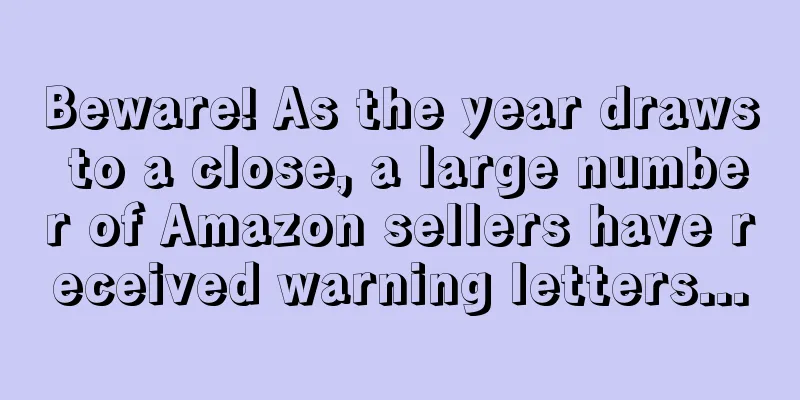Amazon's own brands are in vogue. How should sellers respond?

|
If being an e-commerce platform in the retail industry is like "processing for others ", then having your own brand is like mastering "core technology". And a private brand backed by a large platform is undoubtedly "born with a golden key in its mouth", and can get countless high-quality resources without "struggling".
Private brands have great potential, and retail platforms are entering the market
In fact, the concept of private brands has existed for decades, but has never made much of a splash. In order to reduce their reliance on third-party brands , more and more large retailers are now embarking on the path of branding.
Wal-Mart and Target are typical examples. These two retail giants each have no less than 10 private brands, which can generate $1 billion in sales each year, and Target's latest brand All in Motion even reached the $1 billion sales mark in its first year of launch.
Not to mention Amazon , the world's largest e-commerce retail platform , which launched its first private label, AmazonBasics, 10 years ago , mainly selling household daily necessities.
However, Amazon did not really pay attention to this track until three years ago, when it had only 30 private brands.
According to a Coresight Research report released in May last year , Amazon now has at least 111 private brands offering 22,617 products in categories including food and beverages , automobiles , clothing , home furnishings, pet supplies and electronics . ( Some Amazon brands )
The platform "favors" its own brands, and third-party sellers have a hard time speaking out
The retail platform's own brands are often sold at low prices and good quality , which may be good news for consumers who want to save money , but it has caused concerns among third-party sellers . Among them, the number of Amazon sellers who are worried about being forced to compete with Amazon's own brands accounts for as high as 73% .
Sellers’ concerns are not without reason. Although Amazon claims that its own-brand products only account for 1% of total sales on its platform , sales in some specific categories are growing rapidly .
Amazon ’s private-label brands in the core consumer packaged goods category (household, grocery, baby, pet, beauty and health products) grew 81% between 2017 and 2018, according to Numerator. AmazonBasics has also made great strides , with the number of best-selling products under the brand jumping from 660 to more than 1,300 between April 2018 and April 2020 .
Moreover, Amazon has a large amount of transaction history data on the platform, and operating its own brands may cause unfair competition and disrupt the market order. Unfortunately, such cases are everywhere.
Last August, The Washington Post discovered that Amazon automatically recommended its own-brand products when customers added pricier items to their carts , such as recommending cheaper AmazonBasics batteries to shoppers buying Energizer batteries .
In November 2019, Allbirds co -CEO Joey Zwillinger said that a shoe sold by Amazon 's own brand looks exactly like Allbirds' Wool Runner shoes. Amazon's knockoff shoes are priced at $ 45, half the price of Allbirds shoes .
This undoubtedly forces third-party brand sellers into the battlefield of "price war" .
An investigation by The Wall Street Journal last April found that Amazon used data from third-party sellers to help develop its own-brand products .
Although Amazon argues that third-party sales on the platform account for more than half of the company's total sales, exceeding its own first-party business, so there is no incentive to abuse the trust of third-party brands, and it has formulated policies prohibiting the use of personal seller data to formulate brand strategies, the U.S. House of Representatives Antitrust Panel and the above investigation have pointed out loopholes in these policies :
That could mean that when a single third-party seller dominates overall sales in the space , the aggregate sales data Amazon allows itself to use is actually the individual seller data.
But there is no need to be discouraged. Facing the competitive threat from Amazon's own brands, sellers are not helpless.
"Fighting" or "Refusing to Fight" are both ways out
First, unlike national brands, most of Amazon's own brands have limited exposure on its website and are not as well-known as other mature brands , so customers do not have a high sense of trust in them . Therefore, sellers only need to continue to sell well, provide good service, tell good brand stories, and cultivate consumers' brand loyalty .
Moreover, excellent customer service will bring about a positive chain reaction, triggering customers to leave positive reviews and thus improve your store's ranking .
Second, you can use your own ASIN to create new variations of your existing products , such as bundling your products to make them different from similar products that Amazon may recommend .
Finally, in addition to the above tips, utilizing SEO optimization to drive external traffic to your products and providing easy-to-understand and attractive listings can also help your brand win over the competition. Private Label Amazon |
<<: eBay Greater China Managed Payment is here, and email invitations will be sent starting in April
Recommend
Shenzhen VAT service provider ran away, thousands of tax numbers were affected!
As the end of the year approaches, it is a time o...
Due to an Amazon outage, the seller was deducted 1.71 million and the store was closed!
Imagine that you suddenly received an IOU for $91...
Sniped by "restriction order", all brands of sellers with 70,000 orders per day were closed
Amazon's restrictions on brands are still exp...
What is Lechuang Public Overseas Warehouse? Lechuang Public Overseas Warehouse Review, Features
Levo Public Overseas Warehouse is committed to ser...
Anker is fully committed to developing ChatGPT. Will multiple positions be replaced?
With the popularity of ChatGPT , more and more cr...
Southeast Asia's cross-border e-commerce industry is undergoing a dramatic change. Alibaba International Station provides comprehensive support for Chinese sellers
Recently, Indonesia suddenly introduced new e-com...
With annual revenue of over 1 billion and net profit quadrupled, this major supplier is also going public!
Yien.com learned that Shenzhen Aoni Electronics C...
63% of retailers expect to adopt 5G to improve the online shopping experience
The turmoil in 2020 is accelerating digital trans...
The growth rate of the e-commerce market will slow down, and opening up one's own market will become a trend!
In 2021, online retail has shown a different deve...
What is Plae? Plae Review, Features
Plae is a technology-driven children's lifest...
What is Yijia Overseas Warehouse? Yijia Overseas Warehouse Review, Features
Yijia Overseas Warehouse is an overseas warehouse...
What is Qalo? Qalo Review, Features
Founded in 2013, Qalo started out as a pioneer in ...
What is Keepa
Keepa is a paid Amazon price tracking tool that s...
What is Zomato? Zomato Review, Features
Founded in 2008, Zomato is a food ordering, takea...
What is Lead Ninja? Lead Ninja Review, Features
Lead Ninja can help sellers successfully sell dro...









